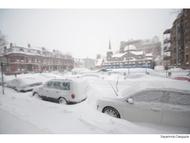Green New Dangers - ORIGINAL CONTENT
- By:
- Edward A. Reid Jr.
- Posted On:
- Mar 5, 2024 at 6:00 AM
- Category
- Energy Policy, Climate Change
Much has been written regarding the effects of the “energy transition” on energy cost, availability, reliability and the structure and operation of the electric grid. Those are all important issues. All are fraught with degrees of uncertainty, since there has not been a successful demonstration of a renewable plus storage grid anywhere and there are no plans to conduct such a demonstration.
Little has been written about the effects of the “energy transition” on the lives of individuals and families who would be totally dependent on the electric grid for their energy needs. These effects would vary significantly depending on the local climate and also on local population density.
Residents of the northern plains, upper Midwest and New England are regularly subjected to harsh winters during which ambient temperatures can drop to as much as 125°F below body temperature. Residents of the southern tier of the US are regularly subjected to hot summers in which ambient temperatures can reach as much as 25°F above body temperature. This difference in ambient temperature relative to body temperature is the underlying reason why cold temperatures contribute to approximately 10 times more deaths more deaths than hot temperatures.
Residents of areas frequently exposed to very low ambient winter temperatures typically use natural gas, propane or fuel oil for space and water heating since these sources are more reliable than the electric grid in severe weather conditions; and, because electric space and water heating is more expensive than the alternatives. The use of electric heat pump space and water heaters is not common because of the poor low temperature performance of typical heat pumps. However, the fossil fuel space and water heating equipment would no longer be available after the “energy transition”.
Many residents in colder climates rely on gasoline or diesel emergency generators or natural gas, propane or diesel standby generators to supply power in the event of a grid outage. However, these generators would no longer be available after the “energy transition”.
Residents in these colder climates would instead be required to rely on electric heat pumps designed for cold weather operation. These heat pumps are beginning to enter the market but are not yet broadly available. They would also be required to rely on batteries to meet their emergency power needs in the event of a grid outage.
The most common gas furnace capacity is 100,000 Btu/hr. A furnace of this heating capacity would require less than 0.5 kW to power its controls and circulating fan, so the furnace could operate continuously in extremely cold weather for one day on a battery capacity of approximately 12 kWh. The Tesla Powerwall has a rated capacity of 13.5 kWh, so a fully charged Powerwall could support a typical gas furnace for approximately a full day, at an installed cost of approximately $9,000 – 13,000.
An electric heat pump operating at very low ambient temperature, or the strip heaters used to back up the heat pump, would require an input of approximately 30 kW to match the output of the gas furnace, or approximately 60 times the electric input required to operate the gas furnace. The installed cost of the Tesla Powerwalls required to operate the heat pump or strip heaters continuously in extremely cold weather for one day would range from $500,000 – 700,000, well beyond the financial reach of most homeowners.
Clearly, the elimination of fossil fuel space and water heating and the elimination of fossil fuel emergency and standby generators would increase the likelihood of deaths caused by grid outages in extremely cold weather. US EPA estimates the value of a “statistical life” at approximately $10 million, so grid outages in extremely cold weather could have both a major human and a major financial cost, with no discernable benefit.


